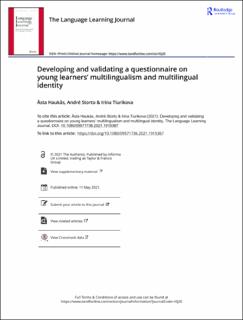| dc.contributor.author | Haukås, Åsta | |
| dc.contributor.author | Storto, Andre | |
| dc.contributor.author | Tiurikova, Irina | |
| dc.date.accessioned | 2021-07-09T11:37:08Z | |
| dc.date.available | 2021-07-09T11:37:08Z | |
| dc.date.created | 2021-05-14T12:50:36Z | |
| dc.date.issued | 2021 | |
| dc.identifier.issn | 0957-1736 | |
| dc.identifier.uri | https://hdl.handle.net/11250/2764051 | |
| dc.description.abstract | Validation of data collection instruments is a necessary step in all research and should be regarded as an integral component in every stage of the research process; however, the validation process is often not accounted for in detail in published studies. The purpose of this paper is to describe the development and validation of the Ungspråk electronic questionnaire, which was designed to explore teenagers’ multilingualism and multilingual identity in the Norwegian school context. It aims to examine whether having a multilingual identity correlates with several variables such as language practices, languages studied in school, open-mindedness, and beliefs about multilingualism. To our knowledge, the Ungspråk questionnaire is one of the first validated tools for quantitatively investigating learners’ multilingual identity in school settings. Different qualitative and quantitative procedures were adopted for validating Ungspråk, including piloting sessions with students from two lower secondary schools. The results of the validation processes suggest that the Ungspråk questionnaire is a robust instrument for investigating young learners’ multilingual identity. It is easy to use, acceptable to learners, and fulfils stringent criteria of reliability and validity. | en_US |
| dc.language.iso | eng | en_US |
| dc.publisher | Routledge | en_US |
| dc.rights | Navngivelse 4.0 Internasjonal | * |
| dc.rights.uri | http://creativecommons.org/licenses/by/4.0/deed.no | * |
| dc.title | Developing and validating a questionnaire on young learners’ multilingualism and multilingual identity | en_US |
| dc.type | Journal article | en_US |
| dc.type | Peer reviewed | en_US |
| dc.description.version | publishedVersion | en_US |
| dc.rights.holder | Copyright 2021 The Author(s). | en_US |
| cristin.ispublished | true | |
| cristin.fulltext | original | |
| cristin.qualitycode | 1 | |
| dc.identifier.doi | https://doi.org/10.1080/09571736.2021.1915367 | |
| dc.identifier.cristin | 1910022 | |
| dc.source.journal | The Language Learning Journal | en_US |
| dc.identifier.citation | The Language Learning Journal, 2021. | en_US |

